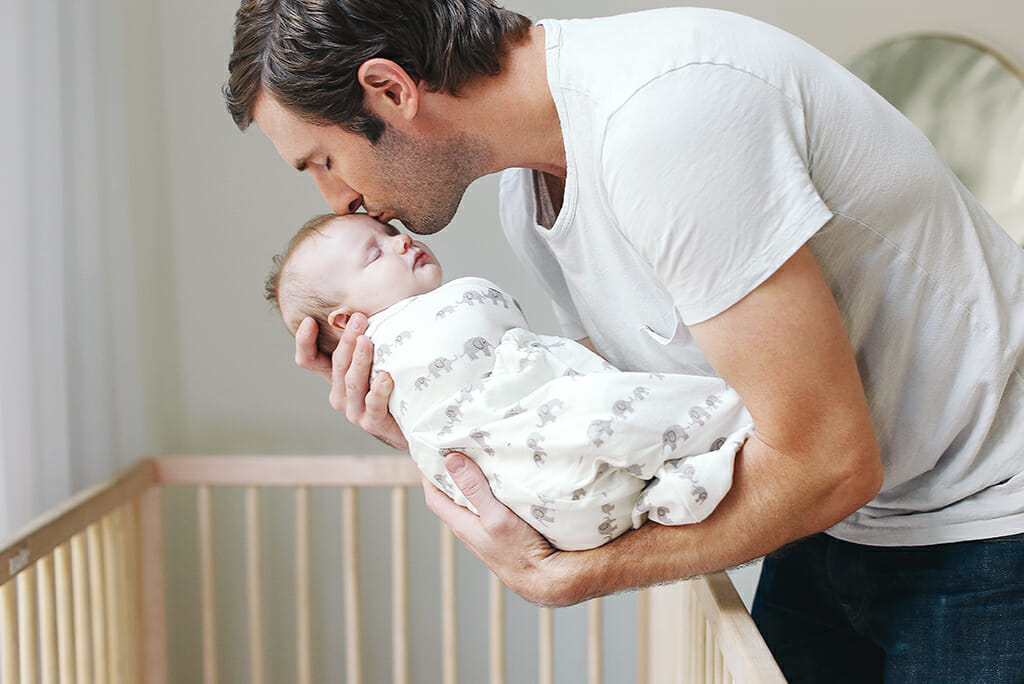
Originally posted at ergobaby.com
Lots of parents often ask about swaddling. Many are not sure of either the best way to do it or even why they should be doing it in the first place. Some parents have tried it previously and have their reasons why they didn’t stick to it: the baby hated to be swaddled, the swaddle never stayed put anyway, I want her arms free so she can self soothe, etc.
How does swaddling help a baby?
Swaddling isn’t just cute because you make a little baby burrito. It’s beneficial for your baby (and you!). While there are lots of reasons why many parents choose not to swaddle their newborn babies, there are far greater reasons why you should! Here are just a few:
Safer sleeping.
Studies have found that newborn babies who are swaddled and placed on their backs in the crib are less likely to pull blankets over their head. Swaddling also makes it harder for babies to roll over onto their fronts, thus further lessening the risk of suffocation. Once your baby can roll onto his tummy, you must stop swaddling. But until then, it can help to decrease the chances of Sudden Infant Death Syndrome.
It is soothing.
There is a theory about the fourth trimester, which believes that babies are actually born three months too soon. This means that the more we can replicate conditions as they were in utero, the more we are able to soothe our newborns. Being swaddled can help newborns feel safe and secure, as well as keep them warm and cozy without overheating. Swaddling recreates the soothing and secure feeling inside the womb, meaning newborns are less likely to cry and more likely to sleep better.
It controls the startle reflex.
Is your baby’s startle reflex getting worse? Some babies wake themselves by flailing their arms and legs when startled by a loud noise. While this is normal for your baby’s neurological development, being swaddled helps to control the startle, or Moro, reflex and thus further allows for better sleep. Preventing your newborn from moving her arms and legs involuntarily also helps to improve her motor skills in general.
Babies cry less when swaddled.
And why wouldn’t they? They’re feeling safe, secure, and soothed in their little cocoon, so why would they cry unless they need something? Many parents have also found swaddling to help colicky babies. The light pressure from the swaddle and feeling of being inside a cocoon imitates the womb, helping with overstimulation and providing much-needed peace for babies and parents.
Swaddling is great for infant reflux.
Babies with infant reflux respond well because the swaddle holds the body in a position that helps to prevent acid travelling back up the oesophagus. It also helps to soothe, as already discussed.
Swaddling Tips for Newborns
Swaddling is gentle, useful, and safe for babies—that is, when it’s done right.
Tip 1: Swaddle from day one.
Chances are nurses swaddled your newborn in the hospital. If they did, don’t stop. If you continue swaddling, so long as it’s safe for your newborn, there shouldn’t be any time for him to start resisting it.
Tip 2: Swaddle snugly, but not too tightly.
The American Academy of Pediatrics says swaddling is fine if the swaddle isn’t too tight and doesn’t make it difficult for your baby to breathe or move her hips. You should be able to slip 2-3 fingers between the swaddle and your baby’s chest, and when practicing hip-healthy swaddling, your baby’s legs should be able to bend up and out at her hips. Swaddle blankets also shouldn’t be too loose so that it comes undone and could cover your baby’s face.
Tip 3: Lay baby on his back.
Whenever you lay your baby down to sleep, always lay him on his back. It’s the safest newborn sleeping position.
Tip 4: Swaddle at the right times.
How often should you swaddle a newborn? Swaddling is best during naps, bedtime, and maybe when your newborn is being fussy. Some parents use swaddling as a sleeptime association. If you choose to swaddle, keep your baby swaddled during nighttime feedings and partially swaddled during night diaper changes. However, you don’t want to swaddle her during daytime feedings or “wake windows”.
Tip 5: Take precautions to prevent overheating.
Swaddling can cause babies to overheat if they’re in a hot room and too warm of clothing while wrapped in a swaddle. Experts recommend keeping a baby’s room between 68-72 degrees Fahrenheit. You should also dress your baby in warm clothes, like a pair of pajamas or bodysuit and pants, but not in layers. Sweating, red cheeks, and rapid breathing are signs your baby is overheating.
Tip 6: Follow your baby’s signs of when to stop.
Babies shouldn’t be swaddled once they’re able to roll over or start becoming more physically active. Some experts say to stop swaddling around 2 months old, while others say you can wait until around 4 months old. Once it’s time to stop, transition your little roller from a swaddle to a baby sleeping bag, or sleep sack, to keep getting the sleep baby needs and you deserve.
About the Author
Rebecca Michi is an English gentle children’s sleep consultant and author based in Seattle. Rebecca works with families who have children under 6 years old and uses only the gentlest techniques and encourages parents to use their instincts when helping their child sleep. Rebecca uses many different gentle sleep training techniques, and never uses cry-it-out. For more information or consultations, find her at her website.






